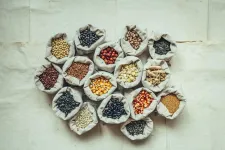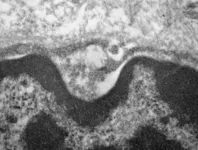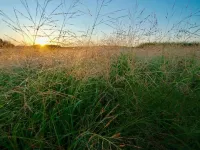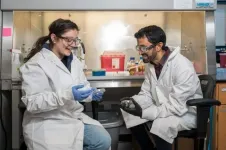(Press-News.org) "Plant a hundred kinds of crops"
Wangjinzhuang village is nestled amongst the steep slopes of the South Taihang Mountains in Hebei Province, China. To prosper in the northern climate, the villagers have developed a tried-and-true strategy: "using the land to plant a hundred kinds of crops and not rely on the sky". Their fields contain red millet, white sorghum, purple and green eyebrow beans, and yellow radishes. Having survived for over a thousand years, this agrobiodiversity is a vibrant cornerstone of the village's agricultural heritage that is too precious to lose.
In an effort to combat dwindling crop diversity across China (the Ministry of Agriculture found that of 11,590 grain crop varieties planted in the country in 1956, only 3,271 varieties remained in 2014), the government has bolstered its system of national genebanks, plus issued recent policy recommendations. These are making positive steps towards large-scale conservation; however, there has been relatively little attention given to the role of the country's 260 million farmers who have saved, used, and contributed to the evolution of diverse, local crops for centuries.
The services provided by China's community seedbanks have been documented for possibly the first time by an article recently published in Frontiers in Sustainable Food Systems. 27 seedbanks were surveyed to understand their ability to meet a wide range of needs, with positive implications for climate resilience, improved farmer livelihoods, and increased food security.
Seedbanks the Chinese way
The seedbank at Wangjinzhuang village, one of the case studies covered by the article, has quickly grown since its establishment in 2019 by a local farmers' association. Now run by 43 members, 26 of whom are women, the seedbank holds viable samples over a hundred crop varieties, including essential grains such as millets and 82 traditional varieties. Members have organized multiplication plots and stipulate that for 1 kg of seeds withdrawn, 1.5 kg must be returned. This, combined with the guidance of plant breeders and a farmer field school, ensures a future supply of seeds that continue to evolve to meet local environmental conditions.
Elsewhere, in Jiangsu Province (a region with 6,000 years of rice paddy culture), economic development and large-scale agriculture have depleted many aquatic crops. But, spurred by increased consumer demand for sustainable and healthy foods, farmers have begun to turn back towards more diverse traditional rice varieties such as Suyunuo, an aromatic sticky rice that had been abandoned for over two decades. This 'lost' crop diversity is being reintroduced at an organic farm backed up by community seed banking. The community seedbank facilitates farmer-to-farmer exchange of seed and brings new diversity to the area through samples obtained from a regional public genebank. However, farmers realized that they no longer knew how to cultivate Suyunuo for the best results. Only by collaborating with public research institutes is it possible for farmers to re-adapt the crop to match new environmental conditions and consumers' interests.
Article author Dr. Yiching Song from the Chinese Academy of Sciences spearheaded the Farmer Seeds Network, a national initiative that organized many seedbanks. She reflects: "Community seedbanks encourage seed and knowledge exchange within and among rural communities, between rural communities and the formal conservation and seed sectors; and add value to local crop diversity through new linkages with markets and cities."
Growing seedbanks across China and beyond
Researchers emphasize the need for policies to recognize the complementary role of community seedbanks within the national conservation system and standardize processes for seed storage and benefit-sharing. Dr. Song notes that a formal system of incentives and rewards would, "encourage farmer communities to establish community seedbanks and work together with plant breeders and other researchers to take care of our country's rich agrobiodiversity."
Further support to develop seedbanks can come through organized training. Ronnie Vernooy is a scientist at the Alliance of Bioversity International and CIAT, which was part of the establishment of China's first-ever community seedbank in 2010. Since then, he says, "The Farmer Seeds Network, using our training handbooks developed for facilitators and farmers, has done remarkable work enabling farmers to open new community seedbanks across China. This is an important and exciting step in building more resilient seed systems."
Takeaways:
* China's wealth of crop biodiversity has been steadily disappearing.
* This can be addressed by community seedbanks, which build on a long tradition of farmer seed saving.
* Policy support and training can ensure that seedbanks are best equipped to conserve biodiversity and provide additional value for farmers.
INFORMATION:
Further reading
The community seedbank handbooks developed by the Alliance of Bioversity International and CIAT were revised in 2020, and have been translated into multiple languages to help establish seedbanks in the Horn of Africa. English versions below:
Facilitator handbook: Community Seed banks: concept and practice
Farmer handbook:
1) How to develop and manage your own community seed bank
2) Technical issues
3) Management, networking, policies and a final checklist
Versions are being made available in English, Chinese, Luo, Ateso, Azandhi, Bari, Dinka, N'dogo, Nuer (South Sudanese), Arabic (Sudanese) and Amharinja, Oromo (Ethiopian).
For more information, please contact scientist Ronnie Vernooy: r.vernooy@cgiar.org
Cardiovascular drugs do not affect COVID-19 outcomes--such as disease severity, hospitalizations, or deaths--according to an analysis of all relevant studies published as of November 2020. The findings are published in the END ...
BOSTON - Significant amounts of atherosclerotic plaque have been found in the coronary arteries of people with HIV, even in those considered by traditional measures to be at low-to-moderate risk of future heart disease, according to a study published in JAMA Network Open.
This finding emerged from the global REPRIEVE (Randomized Trial to Prevent Vascular Events in HIV) study, in which Massachusetts General Hospital (MGH) is playing a key coordinating role. Researchers found that the higher-than-expected levels of plaque could not be attributed simply to traditional cardiovascular disease risk factors like smoking, hypertension, and lipids in the blood, but were independently related to increased arterial inflammation ...
The expected decline in the number of landfills across the United States coupled with bans on disposing large amounts of organic waste in landfills that have been enacted in multiple states has prompted researchers at the U.S. Department of Energy's (DOE's) National Renewable Energy Laboratory (NREL) to examine other ways to grapple with the issue of food waste disposal.
The researchers determined no single solution exists in the United States for dealing with food waste disposal. NREL researchers Alex Badgett and Anelia Milbrandt came to that conclusion after examining the economics involved in five different ways to ...
In Brazil, researchers at the University of São Paulo’s Medical School (FM-USP) have discovered that SARS-CoV-2 infects and replicates in the salivary glands.
Analysis of samples from three types of salivary gland obtained during a minimally invasive autopsy procedure performed on patients who died from complications of COVID-19 at Hospital das Clínicas, FM-USP’s hospital complex, showed that tissues specializing in producing and secreting saliva serve as reservoirs for the novel coronavirus.
The study was supported by FAPESP and reported in an article published in the Journal of Pathology.
The researchers said the discovery ...
Bioenergy crops are an alternative energy source that, unlike fossil fuels, could positively impact the environment by reducing greenhouse gases, soil erosion, and carbon dioxide levels. They can be produced even more sustainably if they are grown on poor quality land unsuitable for food. To make up for the poor land quality, these crops can rely on soil microbes like bacteria and fungi to help them access nutrients and water and store more carbon.
Switchgrass, a native prairie species, is championed as a promising bioenergy crop due to its ability to grow across many climates. ...
BUFFALO, N.Y. - How the media frame stories about science affects the public's perception about scientific accuracy and reliability, and one particular type of narrative can help ameliorate the harm to science's reputation sometimes caused by different journalistic approaches to scientific storytelling, according to a new study led by a University at Buffalo researcher.
"What our experiment shows is that the way the news media talk about science focuses too much attention on individuals in a way that doesn't accurately describe the way science actually works," says ...
Amid calls for racial and social justice nationwide, businesses and educational institutions are grappling with how to adopt more inclusive organizational practices, including more diversified hiring. However, recruitment teams and strategic leaders often blame their lack of a diverse workforce on a lack of diverse applicants. A large study of recruitment data suggests a simple and efficient way of increasing diversity in applicant pools: have more diverse recruitment committees and leadership teams.
The study, led by researchers at the University of Houston's Center for ADVANCING ...
Findings from a study published today [6 July] in the Journal of the American Medical Association (JAMA) have prompted new World Health Organization (WHO) recommendations to use interleukin-6 antagonists in patients with severe or critical COVID-19 along with corticosteroids.
A new analysis of 27 randomised trials involving nearly 11,000 patients found that treating hospitalised COVID-19 patients with drugs that block the effects of interleukin-6 (the interleukin-6 antagonists tocilizumab and sarilumab) reduces the risk of death and the need for mechanical ventilation.
The study, which was coordinated by WHO in partnership with King's College London, University of Bristol, University ...
ITHACA, N.Y. - As offices nationwide spring back to life, interior space designers and architects will soon have an easy-to-use planning tool to place indoor workplace furniture, staff, partitions and ventilation in a manner that maximizes fresh air flow and reduces the risk of airborne pathogens.
The Cornell Environmental Systems Lab in the College of Architecture, Art and Planning will introduce a new indoor module for their existing Eddy3D software, a professional-level airflow and microclimate simulator that can help improve ventilation.
The new indoor module will be released this summer, while the research supporting it will ...
Scientists and engineers are constantly looking for ways to better our world.
Synthetic biology is an emerging field with promise for improving our ability to manufacture chemicals, develop therapeutic medicines such as biopharmaceuticals and vaccines, and enhance agricultural production, among other things. It relies on taking natural or engineered pieces of DNA and combining them in new ways in biological systems, such as microbes, bacteria or other organisms.
According to University of Delaware's Aditya Kunjapur, assistant professor of chemical and biomolecular engineering, as these sophisticated microbial technologies are advanced, scientists need to explore ways to keep these organisms from ending up in the wrong environment.
For example, a bacterium that is good at making ...



